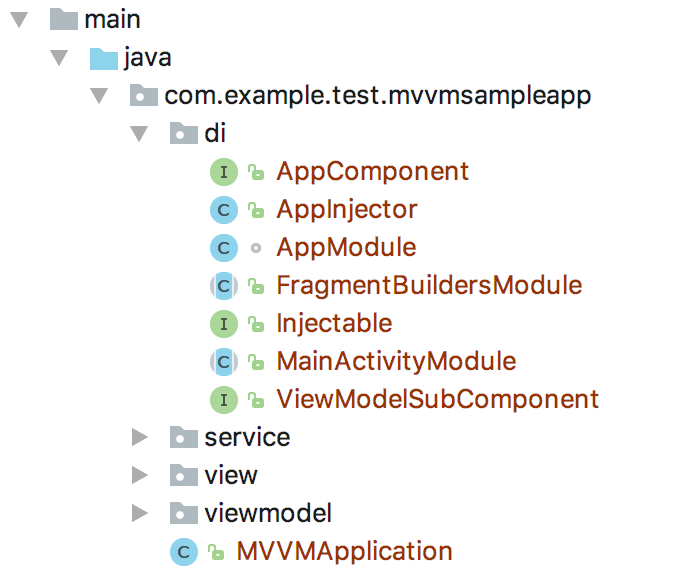原文:MVVM architecture, ViewModel and LiveData (Part 2)
在Google I / O期间,Google推出了包含LiveData 和ViewModel 的architecture components ,这有助于使用MVVM模式开发Android应用程序。 本文讨论这些组件如何为遵循MVVM的Android应用程序提供服务。
在本系列的第一篇文章中,我们讨论了这些组件如何为遵循MVVM的Android应用程序提供服务。 在第二篇文章中,我们将回答在依赖注入的第一篇文章结尾处提出的其中一个问题。
本文假定您具有Dagger的基本知识,因为我们将专注于在MVVM示例中设置最新的Dagger版本(版本2.11)以实现依赖注入。
如果您需要关于Dagger 2.11的基本信息,请查看Dagger用户指南。
配置Dagger 2.11
首先,让我们将Dagger 2.11依赖添加到我们的MVVM Sample。
指定Dagger版本2.11
1 | project.ext { |
1 | annotationProcessor "com.google.dagger:dagger-compiler:$dagger_version" |
1 | compile "com.google.dagger:dagger-android:$project.dagger_version" |
Dagger 2.11项目设置
下图显示了本示例中的主Dagger 2.11设置。

我们主要有以下Dagger App类/接口:
- AppModule是一个Dagger模块,负责在应用程序级别提供单例服务,例如GitHubService和ProjectViewModelFactory。
- AppComponent负责注入AppModule。
- ViewModelSubComponent是创建View Model实例的子组件。
- MainActivityModule和FragmentBuildersModule是Activity和Fragment实例提供程序。
- Injectable只是可注射Fragment的标记接口。
- AppInjector是一个辅助类,用于在实现Injectable接口时自动注入Fragments。
现在,让我们进入这个设置中每个Dagger项目的细节。
创建 View Model SubComponent
以下代码片断显示了ViewModelSubComponent接口,该接口负责创建ViewModel实例:
1 |
|
请注意,ViewModelSubComponent将被ProjectViewModelFactory调用以获取ViewModel实例。
但什么是ProjectViewModelFactory?
下一节回答这个问题。
创建自定义View Model Factory
ProjectViewModelFactory是一个扩展ViewModelProvider.Factory以便将ViewModel实例提供给使用者Fragment类的工厂。
以下代码片段显示了ProjectViewModelFactory,它是一个扩展ViewModelProvider.Factory的自解释Factory实现:
1 |
|
现在,让我们看下一节中的主要应用程序模块。
创建App模块
AppModule是一个Dagger模块,负责在应用程序级别为消费者提供单例服务,例如GitHubService和ProjectViewModelFactory。 以下代码片段显示了AppModule类:
1 | (subcomponents = ViewModelSubComponent.class) |
这里需要注意的一点是,不要忘记通过在@Module注解的subcomponents参数中指定ViewModelSubComponent到AppModule。
创建 Injectable和 AppInjector
可注入接口只是一个普通的空白标记接口,如下所示:
1 | public interface Injectable { |
Injectable将由可注射的Fragment实施。
为了在实现Injectable接口时自动注入片段,将创建以下AppInjector助手类,以在onFragmentCreated()上注入片段实例,如下所示:
1 | public class AppInjector { |
有一点需要注意,AppInjector.init()将在应用程序启动时调用(正如我们将在自定义应用程序类部分中展示的那样)。
创建 Activity 和 Fragment Modules
以下代码片段显示了Fragments Dagger模块:
1 |
|
从Dagger 2.10开始,@ContributesAndroidInjector轻松将活动和片段附加到匕首图上。 以下代码片断显示了MainActivityModule:
1 |
|
现在,我们来看看Dagger 2.11设置中的最后一项,即AppComponent。
创建AppComponent
下一个代码片段显示了AppComponent接口。
1 |
|
有一件重要的事情要注意,除了包括AppModule和MainActivityModule之外,我们还根据官方文档向AppComponent添加了AndroidSupportInjectionModule,该文档声明有必要确保所有必要的绑定都可用。 AndroidSupportInjectionModule是dagger-android中的一个内置模块:
更新存储库层实现
现在,我们完成了设置Dagger 2.11,让我们更新我们现有的应用程序代码,以便利用Dagger依赖注入。
ProjectRepository不再需要手动创建GitHubService服务实例,它所需要做的就是在它的GitHubService实例的构造函数中使用@Inject,如下所示:
1 |
|
更新ViewModel层实现
更新ViewModel图层也是必要的,以避免在此图层内手动从ProjectRepository创建实例。
以下代码片段显示了ProjectViewModel的一个示例,该示例使用@inject注释来注入Application和ProjectRepository实例:
1 | public class ProjectViewModel extends AndroidViewModel { |
更新视图实现(Fragments和主要的Activity)
更新视图层也是必要的,以避免在该图层内手动创建ViewModel类的实例。
以下代码片段显示了ProjectFragment的一个示例:
1 | public class ProjectFragment extends LifecycleFragment implements Injectable { |
这里需要注意的一些重点:
- 现在每个Fragment都必须实现可注入接口。
- Fragment应该引用ViewModelProvider.Factory以获取ViewModel实例。
创建定制 Application类
最后,我们的自定义application类代码如下所示:
1 | public class MVVMApplication extends Application implements HasActivityInjector { |
这里需要注意两点:
- Application必须实现HasActivityInjector,并@Inject DispatchingAndroidInjector
才能从activityInjector()方法返回。 - 在Application类的onCreate()中,我们初始化AppInjector以便在实现Injectable接口时自动注入Fragments。
源代码
在GitHub中检查更新的应用程序的源代码,随意随意分叉和更新,如你所愿:
https://github.com/hazems/mvvm-sample-app/tree/part2
下一步是什么
在本文后,您现在有足够的信息来使用Google Architectural components创建自己的MVVM应用程序。 希望我能为本系列的下一篇文章留有余地,内容包括以下主题:
- 错误处理。
- 在此演示中添加更多功能,以了解Room如何促进SQLite数据操作,以及如何实现有效的缓存。
- 单元测试。
- 我们在哪里可以将Rx用于此架构?
- 我们如何使用Kotlin简化这个实现? (旅程真的有很多有趣的东西 : ))。
如果你喜欢这篇文章,我感谢你的支持与他人分享这篇文章,让伟大的Android社区知道。